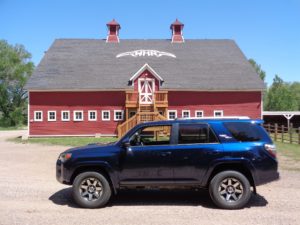
The 2017 Toyota 4Runner looked at home making its way slowly down the dirt road along meandering Crow Creek in the pastures spreading to the east in the huge Wyoming Hereford Ranch, east of Cheyenne.
With old-fashioned body-on-frame construction, the new 4Runner TRD Off-Road Premium 4X4 is one of the more rugged sport-utility vehicles available. To slip into a rut or hit a dip in the road is to feel the tremendous solidity and tightness of the Toyota body and underpinnings.
Passing several extreme offroad opportunities, Jan and I drove the 4Runner to the beautiful setting of the WHR, where I hadn’t visited for several years. It’s been one of the nation’s most prominent Hereford ranches for 130 years, where burial monuments honor Prince Domino, the greatest Hereford sire, and Lerch, the most dominant sire 50 years after Prince Domino.
Steve Anderson, a ranch manager, gave us the run of the place (owners since 1978 are Sloan and Anna Marie Hales). After a couple of photo stops, the Toyota was at its best covering the big spread via the dirt roads.
The 4Runner has a step-in height of 22 inches, indicating it is structured for heavy-duty service, with over 9 inches of ground clearance.
The ride of the 4Runner is okay, though probably doesn’t compare with the sleekness and quality of the many crossover vehicles with unibody design. And it doesn’t compete with a Jeep Grand Cherokee Hemi in performance.
The Toyota’s 4.0-liter V-6 engine, mated to a 5-speed automatic transmission, puts out 270 horsepower and 278 lb.-ft. of torque. This is the same power configuration as was in the 2010 model I tested seven years ago; most competitors have moved to 6-, 7-, 8- and 9-speed transmissions. Though not quick on low-end acceleration, the 4.0-liter has performance aplenty to move the 4,750-pounder up and down the hills.
For engaging four-wheel drive, the transfer case’s mechanical lever sits on the floor just ahead of the transmission shifter. The lever’s normal position is H2 for rear-wheel drive and can be shifted into H4 for four-wheel control at speeds up to 50 miles per hour. An L4 gate offers low-range gear for really tough going.
A dial control for the accommodating terrain settings is placed, awkwardly for the driver, in the overhead console. It alters throttle, gearing and braking for tackling snow, mud, rock and ridges. Normal placement of the terrain dial is on the center console.
Even with some in-town driving at Greeley and Cheyenne and a bit of offroad maneuvering, 220 miles of highway-type travel resulted in an average of 20.5 miles per gallon for the 4Runner. Its EPA estimate is 17/20.
The TRD Off-Road Premium model carried a sticker price of $43,922. A $1,750 option is kinetic dynamic suspension, a hydraulic system that varies the damper rates and sway-bar firmness in offroad situations. Among other options are power moonroof at $850, remote engine start at $499 and paint-protection film at $395.
A survival bag in the cargo area contains gloves, jumper cables, flashlight, tire gauge and bungee cord. Lending easy access to the cargo area, a cavernous 46 cubic feet in size, is a sliding rear deck which can support up to 440 pounds.